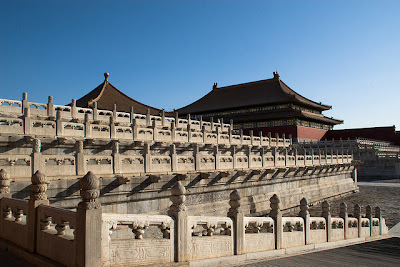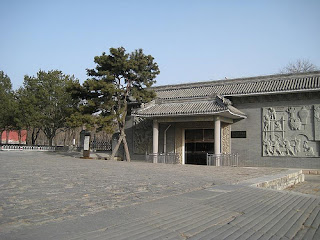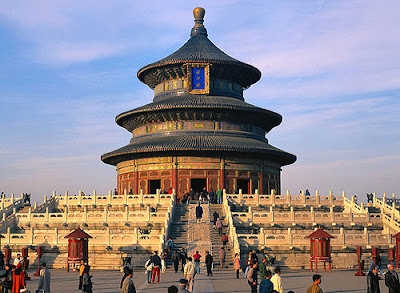In the last article, we have talked about some Beijing dishes and snacks. I think not only Beijing dishes and snacks will attract you but also a great number of tourist attractions and historic sites.In this chapter, We will show you some mystic and historical attractions which is famous in Beijing,even in the world.
Chapter Five
Beijing, Beijing? Old Beijing!
--Wanderlust of Old Beijing
Beijing is unarguably one of the most visited places in the world. Every year finds millions of people come to Beijing to see the capital of China, a fast changing metropolitan city of old and new. There are in fact a great number of tourist attractions and historic sites in Beijing.
If you resort to a travel booklet, you can often see historical Beijing tour plans as below:
● Marvel at the scale and ingenuity of the Great Wall.
● Visit the incredible ancient Forbidden City Home to China's Emperors.
● Visit ancient Ming Tombs and be amazed at what the emperors took with them.
● Be awed at the grandeur of the Imperial Temple of Heaven.
● Be amazed at the beauty and regality of the imperial Summer Palace.
However, those general words about these famous places in Beijing can only give you a little information or some useful travel tips. What you really need in mind are the profound and historical treasures of them which are the outstanding figures of old Beijing.
1. Great Wall: To Be a Hero
 |
| Great Wall |
The incredible Great Wall of China began construction almost 2,500 years ago under the direction of one of the most notorious, short lived, and influential of China's Emperors, Qin Shihuang. The Wall was completed over a period of more than 1,000 years, perhaps due to conflicting dynastic zoning regulations and building codes, not to mention workers dying on the job.
Climbing the Great Wall is a must for you no matter how busy you are! In China, as the saying goes:" One who fails to reach the Great Wall is not a hero." The grand Great Wall is really amazing and good place to challenge. In Beijing there are mainly eight sections of the Great Wall crossing the northern part of Beijing for 600 kms.
The eight sections are Badaling, Juyongguan, Huanghuacheng, Jiankou, Mutianyu, Gubeikou, Jinshanling, and Simatai. Most of the sections of the Great Wall in Beijing are well-preserved and mainly the relics dating from the Ming Dynasty, the time for huge construction. For the Great Wall hiking, get ready for strong footwear. For hot weather, please also prepare for sunblock, sunglasses and water. For cold days, get ready for your hat and heavy coat.
2. Forbidden City: Symbol of the Imperial
 |
| Forbidden City |
The Forbidden City is the ideal place for you to begin your exploration of Beijing by opening its mysterious face. With over 9,000 rooms and over 250 acres, this large palace building was built between 1406 and 1420. It burned down and was rebuilt, sacked and renovated for times, so most of the architecture you can see today dates back to the 18th century in the Qing Dynasty.
There are many famous spots in Forbidden City. For example, the main entry point Meridian Gate, other well-known gate is the Gate of Supreme Harmony, which opens up to a courtyard that held audiences of 100,000. The three great ceremonial halls, Hall of supreme Harmony, Hall of Middle Harmony and Hall of Preserving Harmony are also must-see spots. At the northern end of the compound is the delightful Imperial Garden with gnarled cypresses, scholars' rocks and pavilions.
3. Ming Tombs: Awe to the Imperial
 |
| Ming Tombs |
Located 50 kilometers northwest of the downtown Beijing, noted as the 13 Tombs, this is the burial area of 13 out of 17 emperors of the Ming Dynasty, the ruling dynasty of China from 1368 to 1644. It was the final dynasty in China administered by ethnic Hans. The Ming Tombs is an example if the important laid upon showing proper filial piety and the self-grandeur of the emperors, many of whom begun construction ending only when they moved in.
At present there are only two tombs which have been dug and open to the public: Dingling Tomb and Changling Tomb. Changling Tomb is the first tomb to be excavated. It took two years for the digging and restoration, and was opened in 1958. Dingling has been excavated so completely that people now have to go into the burial chamber itself. However, it is a very deep climb down and people with problems of their heart or kneels are not advised to visit the underground tomb.
4. Temple of Heaven: Pray in faith
 |
| Temple of Heaven |
Built between 1409 and 1420, the Temple of Heave is one of Beijing's most impressive parks in terms of architecture, color and significance. The Temple is basically a huge communications terminal which the Emperor used to communicate directly with Heaven. Several times a year, the Emperor would come here to pray for good harvests, enough rain and other heavenly boons. The construction of the Temple is based around the number nine, the largest of the single digits, which is divine in Chinese numerology.
This temple is situated in the southern Beijing City. It has been one of the most sacred sites for the whole country for the past five centuries. It worked as sacrificial compound buildings for the Ming and Qing emperors. It boasts of the largest sacrificial place in Beijing among a few imperial altars to Heaven, Earth, the Sun, the Moon super natures.
5. Summer Palace: Grand Imperial Garden
The Summer Palace, originally named Qingyi Yuan or the Garden of Clear Ripples, was first constructed in 1750 which was supposed to serve as a summer resort for the Empress Dowager Cixi.
 |
Summer Palace
|
Regarded as the largest imperial garden in China, Beijing's Summer Palace is in fact a park-styled royal retreat extending out over 10 square miles in northwest suburban Beijing. Once a summer resort for emperors, a 290-acre partk-palace is still a retreat for visitors, who can take a rest here or wander around old pavilions, buildings, temples, bridges and the huge lake - Kunming Lake.
Summer Palace is mainly comprised of Longevity Hill (Washoushan) and Kunming Lake. Much of the park is covered by Kunming Lake. With masterly design and artistic architecture integrating the highlight of Chinese garden arts, the Summer Palace has earned a title of "Royal Garden Museum". It is a royal garden most completely preserved with richest landscapes and large compact buildings. The Summer Palace was listed as the world cultural heritage in 1998.
The Summer Palace is a monument to classical Chinese architecture, in terms of both garden design and construction. Borrowing scenes from surrounding landscapes, it radiates not only the grandeur of an imperial garden but also the beauty of nature in seamless combination that best illustrates the guiding principle of traditional Chinese garden design: “The works of men should match the works of Heaven”.
All in all, old Beijing still have varies of old places for you explore, even you just turn around a street corner can you find out old things of Beijing that interest you deeply.
Have you discovered something of old Beijing? Let’s share those thrill things together to fulfill our wanderlust in old Beijing.
No comments:
Post a Comment
Thanks for your comment and welcome to China!